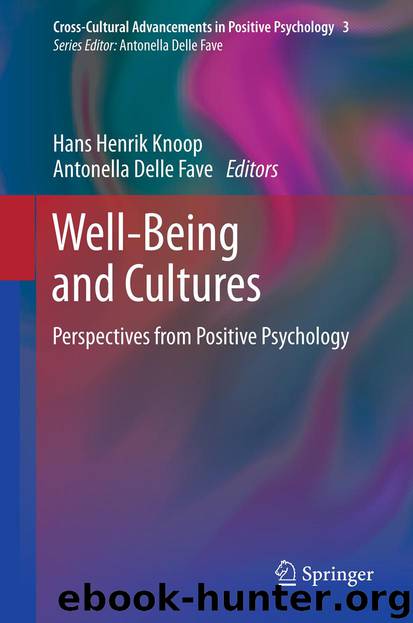Well-Being and Cultures by Hans Henrik Knoop & Antonella Delle Fave

Author:Hans Henrik Knoop & Antonella Delle Fave
Language: eng
Format: epub
Publisher: Springer Netherlands, Dordrecht
Nature as a Positive Experience
Unlike the topic mentioned above and although it is a classic theme in the environmental psychology field, the positive psychological effects triggered by natural environments have been poorly investigated in a cross-cultural perspective.
This happened because the main theories of the field had an evolutionary orientation in attempting to settle the universal processes that can explain the phenomenon and by doing so disregarded the possible cultural variations.
Even if natural benefits are long since known in the popular culture, a first attempt to scientific demonstration of this common understanding was proposed in the psychological field only since the 1970s, with the pioneer works of Kaplan and Kaplan (1978, 1982) and Ulrich (1981, 1984).
In that period in fact, environmental psychology was beginning its transition from an architectonic paradigm to another characterized by a strong attention to nature, proenvironmental behaviors, and sustainability in general.
Currently, a large body of research has shown amply that exposure to natural landscapes has positive effects, such as the promotion of cognitive and emotional development (Wells 2000), individual health and trauma resilience (Ulrich 1984), on individuals on a cross-cultural level.
Hence, several theoretical frameworks give different explanations of how this positive effect is generated.
The main theoretical frameworks, namely, the Attention Restoration Theory (Kaplan and Kaplan 1989; Kaplan 1995) and the Stress Recovery Theory (Ulrich et al. 1991), tend to explain the environment-well-being relationship as an automatic regulation system, within which people unwittingly regain normal levels of cognitive functioning after a period of mental fatigue.
The Attention Restoration Theory was based on two theoretical frameworks, summarized by Kaplan in a biocognitive theory of the man-environment relationship.
The first framework was the seminal work of Berlyne (1950, 1954), stating the evolutionary importance of collative stimuli (novelty, complexity) to help human learning and environmental exploration.
The second was the distinction between voluntary and involuntary attention (James 1892), in which the former is needed to carry on the normal activities of everyday life, often involving a low personal stimulation, and the latter identifies an automatic capture of attention generated by the context of the current activity.
This involvement, which Kaplan called fascination, is supposed to be useful as it facilitates the recovery from the fatigue of the directed attention and is favored by the natural context because of our phylogenetic past in a natural world.
Therefore, a restorative place is a landscape full of fascinating features, but at the same time, it is perceived as being very different from the everyday spaces (being away) and compatible with cognitive schemata (compatibility).
Moreover, Korpela (1992) suggested that a higher local restorativeness was correlated to a higher place preference, and that people used the favorite places strategically as “reserves” of cognitive clarity.
The Stress Recovery Theory (Ulrich 1984) offered indeed a simpler explanation, adopting the same evolutionary paradigm but suggesting a stress-related approach. In his seminal research, Ulrich tested the postsurgery complications in patients with the same disease but with a different spatial location within the hospital.
Patients with an open view on the inner garden were found to have a shorter
Download
This site does not store any files on its server. We only index and link to content provided by other sites. Please contact the content providers to delete copyright contents if any and email us, we'll remove relevant links or contents immediately.
Rewire Your Anxious Brain by Catherine M. Pittman(18491)
Talking to Strangers by Malcolm Gladwell(13134)
The Art of Thinking Clearly by Rolf Dobelli(10142)
Mindhunter: Inside the FBI's Elite Serial Crime Unit by John E. Douglas & Mark Olshaker(9105)
Becoming Supernatural by Dr. Joe Dispenza(8040)
Change Your Questions, Change Your Life by Marilee Adams(7566)
The Road Less Traveled by M. Scott Peck(7475)
Nudge - Improving Decisions about Health, Wealth, and Happiness by Thaler Sunstein(7460)
The Lost Art of Listening by Michael P. Nichols(7360)
Mastermind: How to Think Like Sherlock Holmes by Maria Konnikova(7164)
Enlightenment Now: The Case for Reason, Science, Humanism, and Progress by Steven Pinker(7084)
Win Bigly by Scott Adams(7033)
The Way of Zen by Alan W. Watts(6452)
Daring Greatly by Brene Brown(6369)
Big Magic: Creative Living Beyond Fear by Elizabeth Gilbert(5556)
Grit by Angela Duckworth(5449)
Ego Is the Enemy by Ryan Holiday(5228)
Men In Love by Nancy Friday(5114)
Altered Sensations by David Pantalony(5005)
